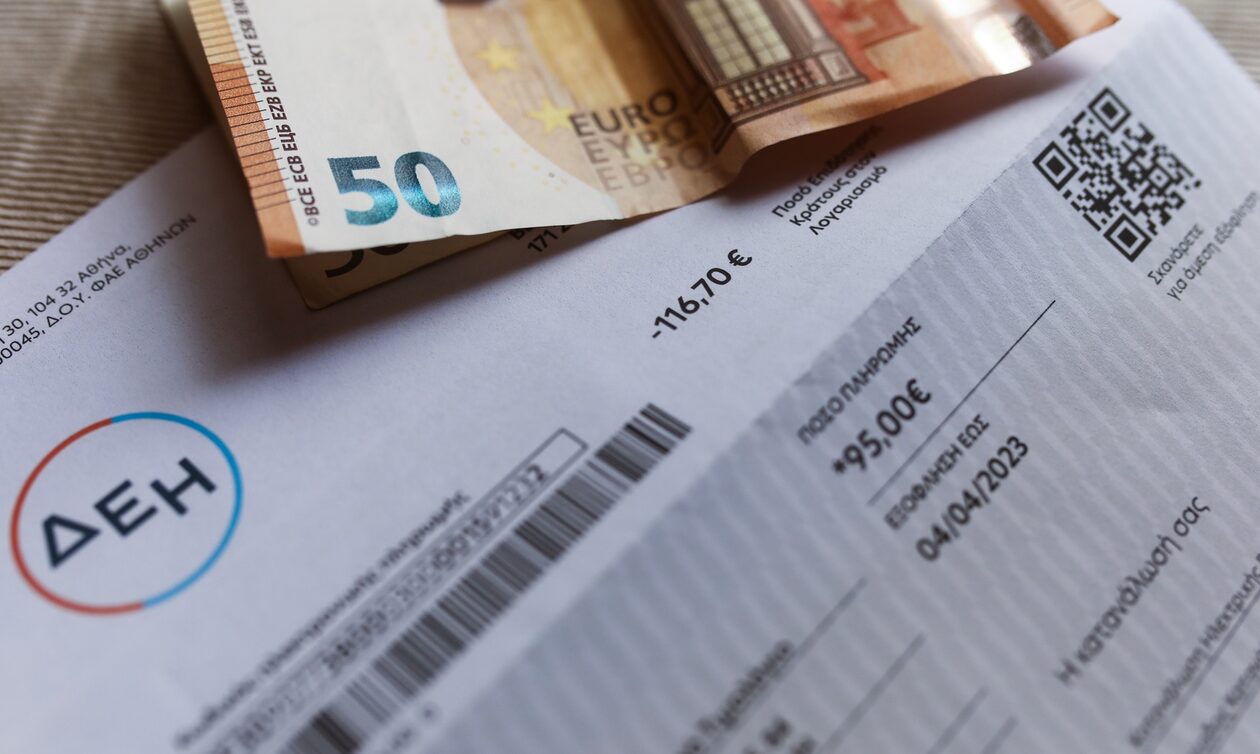
Electricity Bills: their definitions will remain unchanged electricity And in July.
PPC electricity charges remain at the current June level, while the majority of suppliers who have so far announced their July charges have fluctuated slightly.
In particular, the charges announced by PPC are 15.5 cents per kilowatt-hour for consumption up to 500 kilowatt-hours and 16.7 cents for consumption over 500 kilowatt-hours. For overnight electricity, the fee remains 11.4 cents, too.
Indicative invoices from other suppliers:
Protargia home value: 0.11115 cents per kilowatt-hour (from 0.1265)
Heron PROTECT 4 Home: 16.9 cents per kilowatt-hour (unchanged)
Elpedison economy: 11.1 cents per kWh (up from 11.4)
On-time NRG: 13.2 cents per kilowatt-hour (up from 12.2)
Watts and volts: 11.15 cents per kilowatt-hour (from 12.65)
Hellenic Energy Company MAXI Free: 12.3 cents per kWh (no change)
Volterra: 13.98 cents per kilowatt-hour (from 11.98)
Zenith Home Now: 14.4 cents per kilowatt-hour (up from 13.9)
Volton Home: 15.6 cents per kilowatt-hour (from 16.63)
Prices are being announced during a period of rising international prices for natural gas which, however, are still at levels up to 80-90% lower than last summer.
Electricity bills: These are the hidden charges you weren’t aware of
The price of electricity itself may have gone down, but the “round-up” fee does not allow for lower electricity bills.
In fact, bills are often inflated compared to pre-energy crisis levels.
These are the fees that businesses and households pay through their electricity bills for using the system operated by ADMIE, using the network operated by DEDDIE and public utility services (PUS) which covers the subsidized tariff for unconnected islands (so this must be standardized with the tariff for the mainland) and the subsidized tariff for consumers Vulnerable people who join CTO.
As noted by the Kathimerini report, the first “invisible” increases for consumers, who have been eagerly searching for the lowest price per kilowatt-hour among service providers for several months now, came last September.
As of September 1, the ADMIE system fee for households and companies connected to low voltage has been revised from 6.35 EUR/MWh to 9.78 EUR/MWh, for companies with medium voltage from 1.384 EUR/MWh to 3.869 EUR/MWh and for companies with high voltage (energy-intensive industries) from 1.963 EUR/MWh to 3.728 EUR/MWh.
The second “hidden” increase came as of May 1 in network fees that are paid through electricity bills and end up in the department’s coffers, in implementation of a decision issued by the Energy Regulatory Authority (RAE) two months ago.
The competent authority has agreed, on a proposal by DEDDIE, to revise the approved annual income for 2023 recovered through electricity bills from €744m to €981m.
In addition, RAE, with the same decision, implemented a new methodology for calculating network charges.
So far, the largest amount of charge corresponds to 80% of the power (that is, consumption) and 20% of the power (single-phase, three-phase).
With the new methodology, energy charges are compatible with 60% and 40%, based on the rationale of incentivizing consumers to convert three-phase consumption to single-phase consumption in order to obtain lower charges.
By the RAE’s decision, energy charges were revised from May to 4.434 euros per kVA per year from 0.52 euros today and energy charges were reduced to 0.01415 euros/kWh from 0.0213 euros/kWh.
These adjustments weight the final electricity bill of the average household (with 25 kVA three-phase power supply and consumption of 3750 kWh per year) by 7.5% from the €98 collected so far from May 1 until the end of 2023 €174 per year will be charged.
For industries, since May, grid charges have increased by 60% to 120% depending on the operating profile burdening the overall energy bill, up about 6%.
The new methodology predicts medium voltage industries to lose 225% in energy charges (from 1,097 EUR/kW to 3,568 EUR/kWh) and 48% in energy charges (from 0.0028 EUR/kWh to 0.00413 EUR/kWh).
The RAE also predicts a fee gradient based on the peak areas it identifies, which, however, since industry representatives report to “K,” “is impossible for the industry to follow because it can’t change its shifts every time.”
The result of these increases is, according to the same factors, for example, an industry with a load factor of 75% will have an increase of 95% (because it also operates in peak hours) and an industry with a load factor of 37% will have an increase of 58%.
“In absolute terms, the cost of the medium voltage industry is now at the level of 10 EUR/MWh from 5-6 EUR/MWh before May,” industry representatives assure “K”.
Electricity bills: how much chargers “burn”.
The habit of leaving chargers in sockets is not as innocent as we like to think…
Why not leave the charger plugged in when it’s not charging any devices?
The reason will unpleasantly surprise you.
There are many claims and rumors about the correct and incorrect use of chargers.
However, some of them are based on the truth. An example for everyone is the one who says that a charger should not be left connected to the mains.
The most common argument is the potential fire hazard.
However, this is far from the only reason, although it turned out to be justified.
Find out what other arguments should lead you to the correct use of chargers.
A plugged in but unused charger costs money because it burns electricity.
Given the increase in electricity prices and the number of devices that require recharging every now and then, this reason is not insignificant.
Try to figure out how many chargers you have in the house – if you live in a four-person household with two teenage children, that number might look something like this
Mobile phone charger – 4x, laptop charger – 4x, electronic cigarette charger – 2x, charger for smartwatch and other devices – 3x. So you will have a total of 13 chargers.
If you leave them all plugged in for at least three hours a day without any devices plugged in, their annual consumption will be about 185 Wh per year on a single charger.
The risk of fire and other accidents is also high although the probability is small.
Perhaps the most favorable argument is the risk of fire when the charger is “empty”.
Most people plug their chargers into low-frequency outlets, so they’ll likely forget to unplug them.
Although all electrical equipment must now comply with certain standards, there are still those who break the regulations – and they are the dangerous people.
According to the Federal Consumers Union, some chargers manufactured in China do not meet relevant technical standards.
The average price for resident consumers based on current data appears to drop slightly to less than €0.20 per kWh (competitive charge).
The government is likely to grant a lower subsidy for April, below €0.04 per kWh in order to shape final consumer prices at levels of €0.15 to €0.17 per kWh.

“Avid problem solver. Extreme social media junkie. Beer buff. Coffee guru. Internet geek. Travel ninja.”





More Stories
With reductions in electricity tariffs – Newsbomb – News
Are you okay when you tell us we're okay?
A new wave of retirement journeys – we will reach a record high in 2024 with more than 212,000 retirements – a ceiling of €400 million